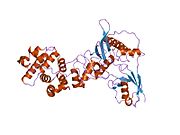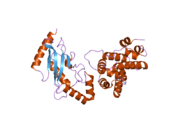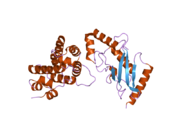SUMO-conjugating enzyme UBC9 is an enzyme that in humans is encoded by the UBE2I gene. [5] It is also sometimes referred to as "ubiquitin conjugating enzyme E2I" or "ubiquitin carrier protein 9", even though these names do not accurately describe its function.
Expression
Four alternatively spliced transcript variants encoding the same protein have been found for this gene. [6]
Function
The UBC9 protein encoded by the UBE2I gene constitutes a core machinery in the cell's sumoylation pathway. Sumoylation is a process in which a Small Ubiquitin-like MOdifier (SUMO) is covalently attached to other proteins in order to modify their behaviour. For example, sumoylation may affect a protein's localization in the cell, its ability to interact with other proteins or DNA.
UBC9 performs the third step in the sumoylation life cycle: the conjugation step. When SUMO protein precursors are first expressed, they first undergo a maturation step in which the four C-terminal amino acids are removed, revealing a di- glycine motif. In a second step, an E1 activating complex binds to SUMO at its di-glycine and passes it on to the E2 protein Ubc9, where it forms a thioester bond with a cysteine residue within Ubc9's catalytic pocket. The loaded Ubc9 is now ready to perform the sumoylation of its various target proteins (also called substrates). It recognizes a particular motif of amino acid residues in these substrates: A large hydrophobic residue, followed by a lysine, followed by a spacer, followed by an acidic residue. This motif is usually described in shorthand as ΨKxD/E. The central lysine within the substrate's recognition motif is inserted into the catalytic pocket. There the carboxyl terminus of SUMO's di-glycine forms a peptide bond with the ε-amino group of the lysine. This process can be assisted by an E3 ligase protein.
The sumoylation process is reversible. SENP proteases can remove SUMO from sumoylated proteins, freeing it to be used in further sumoylation reactions.
Clinical significance relevance
The protein UBC9 encoded by the UBE2I gene has been shown to be targeted by multiple viruses, including HIV and HPV. It has been hypothesized that these viruses hijack UBC9 to serve their own purposes. [7]
Interactions
UBE2I has been shown to interact with:
- ATF2, [8]
- Androgen receptor, [9]
- BLMH, [10]
- DACH1, [11] [12]
- DNMT3A, [13]
- DNMT3B, [14]
- DAXX, [15] [16]
- ETS1, [17]
- FHIT, [18]
- IPO13, [19]
- MAP3K1 [20] and
- MITF, [21]
- P53, [22] [23] [24] [25]
- PIAS1, [26] [27] [28]
- PIAS2, [11] [26]
- RAD51, [22] [29]
- RANBP2, [30] [31]
- RANGAP1, [15] [30] [32]
- SAE2, [15] [30]
- SALL1, [33]
- SUMO1, [22] [23] [30] [32]
- TCF3, [34]
- TNFRSF1A, [20]
- TOP1, [35] and
- WT1. [36]
Notes
- ^ a b c GRCh38: Ensembl release 89: ENSG00000103275 – Ensembl, May 2017
- ^ a b c GRCm38: Ensembl release 89: ENSMUSG00000015120 – Ensembl, May 2017
- ^ "Human PubMed Reference:". National Center for Biotechnology Information, U.S. National Library of Medicine.
- ^ "Mouse PubMed Reference:". National Center for Biotechnology Information, U.S. National Library of Medicine.
- ^ Watanabe TK, Fujiwara T, Kawai A, Shimizu F, Takami S, Hirano H, Okuno S, Ozaki K, Takeda S, Shimada Y, Nagata M, Takaichi A, Takahashi E, Nakamura Y, Shin S (March 1996). "Cloning, expression, and mapping of UBE2I, a novel gene encoding a human homologue of yeast ubiquitin-conjugating enzymes which are critical for regulating the cell cycle". Cytogenet Cell Genet. 72 (1): 86–9. doi: 10.1159/000134169. PMID 8565643.
- ^ "Entrez Gene: UBE2I ubiquitin-conjugating enzyme E2I (UBC9 homolog, yeast)".
- ^ Varadaraj A, Mattoscio D, Chiocca S (Jan 2014). "SUMO Ubc9 enzyme as a viral target". IUBMB Life. 66 (1): 27–33. doi: 10.1002/iub.1240. PMID 24395713. S2CID 42047371.
- ^ Firestein R, Feuerstein N (March 1998). "Association of activating transcription factor 2 (ATF2) with the ubiquitin-conjugating enzyme hUBC9. Implication of the ubiquitin/proteasome pathway in regulation of ATF2 in T cells". J. Biol. Chem. 273 (10): 5892–902. doi: 10.1074/jbc.273.10.5892. PMID 9488727.
- ^ Poukka H, Aarnisalo P, Karvonen U, Palvimo JJ, Jänne OA (July 1999). "Ubc9 interacts with the androgen receptor and activates receptor-dependent transcription". J. Biol. Chem. 274 (27): 19441–6. doi: 10.1074/jbc.274.27.19441. PMID 10383460.
- ^ Koldamova RP, Lefterov IM, DiSabella MT, Lazo JS (Dec 1998). "An evolutionarily conserved cysteine protease, human bleomycin hydrolase, binds to the human homologue of ubiquitin-conjugating enzyme 9". Mol. Pharmacol. 54 (6): 954–61. doi: 10.1124/mol.54.6.954. PMID 9855622.
- ^ a b Rual JF, Venkatesan K, Hao T, Hirozane-Kishikawa T, Dricot A, Li N, Berriz GF, Gibbons FD, Dreze M, Ayivi-Guedehoussou N, Klitgord N, Simon C, Boxem M, Milstein S, Rosenberg J, Goldberg DS, Zhang LV, Wong SL, Franklin G, Li S, Albala JS, Lim J, Fraughton C, Llamosas E, Cevik S, Bex C, Lamesch P, Sikorski RS, Vandenhaute J, Zoghbi HY, Smolyar A, Bosak S, Sequerra R, Doucette-Stamm L, Cusick ME, Hill DE, Roth FP, Vidal M (October 2005). "Towards a proteome-scale map of the human protein-protein interaction network". Nature. 437 (7062): 1173–8. Bibcode: 2005Natur.437.1173R. doi: 10.1038/nature04209. PMID 16189514. S2CID 4427026.
- ^ Machon O, Backman M, Julin K, Krauss S (October 2000). "Yeast two-hybrid system identifies the ubiquitin-conjugating enzyme mUbc9 as a potential partner of mouse Dac". Mech. Dev. 97 (1–2): 3–12. doi: 10.1016/s0925-4773(00)00402-0. PMID 11025202. S2CID 14154139.
- ^ Ling Y, Sankpal UT, Robertson AK, McNally JG, Karpova T, Robertson KD (2004). "Modification of de novo DNA methyltransferase 3a (Dnmt3a) by SUMO-1 modulates its interaction with histone deacetylases (HDACs) and its capacity to repress transcription". Nucleic Acids Res. 32 (2): 598–610. doi: 10.1093/nar/gkh195. PMC 373322. PMID 14752048.
- ^ Kang ES, Park CW, Chung JH (Dec 2001). "Dnmt3b, de novo DNA methyltransferase, interacts with SUMO-1 and Ubc9 through its N-terminal region and is subject to modification by SUMO-1". Biochem. Biophys. Res. Commun. 289 (4): 862–8. doi: 10.1006/bbrc.2001.6057. PMID 11735126.
- ^ a b c Knipscheer P, Flotho A, Klug H, Olsen JV, van Dijk WJ, Fish A, Johnson ES, Mann M, Sixma TK, Pichler A (August 2008). "Ubc9 sumoylation regulates SUMO target discrimination". Mol. Cell. 31 (3): 371–82. doi: 10.1016/j.molcel.2008.05.022. PMID 18691969.
- ^ Ryu SW, Chae SK, Kim E (Dec 2000). "Interaction of Daxx, a Fas binding protein, with sentrin and Ubc9". Biochem. Biophys. Res. Commun. 279 (1): 6–10. doi: 10.1006/bbrc.2000.3882. PMID 11112409.
- ^ Hahn SL, Wasylyk B, Criqui-Filipe P, Criqui P (September 1997). "Modulation of ETS-1 transcriptional activity by huUBC9, a ubiquitin-conjugating enzyme". Oncogene. 15 (12): 1489–95. doi: 10.1038/sj.onc.1201301. PMID 9333025. S2CID 26170389.
- ^ Shi Y, Zou M, Farid NR, Paterson MC (Dec 2000). "Association of FHIT (fragile histidine triad), a candidate tumour suppressor gene, with the ubiquitin-conjugating enzyme hUBC9". Biochem. J. 352 (2): 443–8. doi: 10.1042/0264-6021:3520443. PMC 1221476. PMID 11085938.
- ^ Mingot JM, Kostka S, Kraft R, Hartmann E, Görlich D (July 2001). "Importin 13: a novel mediator of nuclear import and export". EMBO J. 20 (14): 3685–94. doi: 10.1093/emboj/20.14.3685. PMC 125545. PMID 11447110.
- ^ a b Saltzman A, Searfoss G, Marcireau C, Stone M, Ressner R, Munro R, Franks C, D'Alonzo J, Tocque B, Jaye M, Ivashchenko Y (April 1998). "hUBC9 associates with MEKK1 and type I TNF-alpha receptor and stimulates NFkappaB activity". FEBS Lett. 425 (3): 431–5. doi: 10.1016/s0014-5793(98)00287-7. PMID 9563508. S2CID 84816080.
- ^ Xu W, Gong L, Haddad MM, Bischof O, Campisi J, Yeh ET, Medrano EE (March 2000). "Regulation of microphthalmia-associated transcription factor MITF protein levels by association with the ubiquitin-conjugating enzyme hUBC9". Exp. Cell Res. 255 (2): 135–43. doi: 10.1006/excr.2000.4803. PMID 10694430.
- ^ a b c Shen Z, Pardington-Purtymun PE, Comeaux JC, Moyzis RK, Chen DJ (October 1996). "Associations of UBE2I with RAD52, UBL1, p53, and RAD51 proteins in a yeast two-hybrid system". Genomics. 37 (2): 183–186. doi: 10.1006/geno.1996.0540. PMID 8921390.
- ^ a b Minty A, Dumont X, Kaghad M, Caput D (November 2000). "Covalent modification of p73alpha by SUMO-1. Two-hybrid screening with p73 identifies novel SUMO-1-interacting proteins and a SUMO-1 interaction motif". J. Biol. Chem. 275 (46): 36316–23. doi: 10.1074/jbc.M004293200. PMID 10961991.
- ^ Gallagher WM, Argentini M, Sierra V, Bracco L, Debussche L, Conseiller E (June 1999). "MBP1: a novel mutant p53-specific protein partner with oncogenic properties". Oncogene. 18 (24): 3608–16. doi: 10.1038/sj.onc.1202937. PMID 10380882.
- ^ Bernier-Villamor V, Sampson DA, Matunis MJ, Lima CD (February 2002). "Structural basis for E2-mediated SUMO conjugation revealed by a complex between ubiquitin-conjugating enzyme Ubc9 and RanGAP1". Cell. 108 (3): 345–56. doi: 10.1016/s0092-8674(02)00630-x. PMID 11853669. S2CID 15512250.
- ^ a b Lee BH, Yoshimatsu K, Maeda A, Ochiai K, Morimatsu M, Araki K, Ogino M, Morikawa S, Arikawa J (Dec 2003). "Association of the nucleocapsid protein of the Seoul and Hantaan hantaviruses with small ubiquitin-like modifier-1-related molecules". Virus Res. 98 (1): 83–91. doi: 10.1016/j.virusres.2003.09.001. PMID 14609633.
- ^ Sapetschnig A, Rischitor G, Braun H, Doll A, Schergaut M, Melchior F, Suske G (October 2002). "Transcription factor Sp3 is silenced through SUMO modification by PIAS1". EMBO J. 21 (19): 5206–15. doi: 10.1093/emboj/cdf510. PMC 129032. PMID 12356736.
- ^ Kahyo T, Nishida T, Yasuda H (September 2001). "Involvement of PIAS1 in the sumoylation of tumor suppressor p53". Mol. Cell. 8 (3): 713–8. doi: 10.1016/s1097-2765(01)00349-5. PMID 11583632.
- ^ Kovalenko OV, Plug AW, Haaf T, Gonda DK, Ashley T, Ward DC, Radding CM, Golub EI (April 1996). "Mammalian ubiquitin-conjugating enzyme Ubc9 interacts with Rad51 recombination protein and localizes in synaptonemal complexes". Proc. Natl. Acad. Sci. U.S.A. 93 (7): 2958–63. Bibcode: 1996PNAS...93.2958K. doi: 10.1073/pnas.93.7.2958. PMC 39742. PMID 8610150.
- ^ a b c d Ewing RM, Chu P, Elisma F, Li H, Taylor P, Climie S, McBroom-Cerajewski L, Robinson MD, O'Connor L, Li M, Taylor R, Dharsee M, Ho Y, Heilbut A, Moore L, Zhang S, Ornatsky O, Bukhman YV, Ethier M, Sheng Y, Vasilescu J, Abu-Farha M, Lambert JP, Duewel HS, Stewart II, Kuehl B, Hogue K, Colwill K, Gladwish K, Muskat B, Kinach R, Adams SL, Moran MF, Morin GB, Topaloglou T, Figeys D (2007). "Large-scale mapping of human protein-protein interactions by mass spectrometry". Mol. Syst. Biol. 3: 89. doi: 10.1038/msb4100134. PMC 1847948. PMID 17353931.
- ^ Zhang H, Saitoh H, Matunis MJ (September 2002). "Enzymes of the SUMO modification pathway localize to filaments of the nuclear pore complex". Mol. Cell. Biol. 22 (18): 6498–508. doi: 10.1128/mcb.22.18.6498-6508.2002. PMC 135644. PMID 12192048.
- ^ a b Tatham MH, Kim S, Yu B, Jaffray E, Song J, Zheng J, Rodriguez MS, Hay RT, Chen Y (August 2003). "Role of an N-terminal site of Ubc9 in SUMO-1, -2, and -3 binding and conjugation". Biochemistry. 42 (33): 9959–69. doi: 10.1021/bi0345283. PMID 12924945.
- ^ Netzer C, Bohlander SK, Rieger L, Müller S, Kohlhase J (August 2002). "Interaction of the developmental regulator SALL1 with UBE2I and SUMO-1". Biochem. Biophys. Res. Commun. 296 (4): 870–6. doi: 10.1016/s0006-291x(02)02003-x. PMID 12200128.
- ^ Huggins GS, Chin MT, Sibinga NE, Lee SL, Haber E, Lee ME (October 1999). "Characterization of the mUBC9-binding sites required for E2A protein degradation". J. Biol. Chem. 274 (40): 28690–6. doi: 10.1074/jbc.274.40.28690. PMID 10497239.
- ^ Mao Y, Sun M, Desai SD, Liu LF (April 2000). "SUMO-1 conjugation to topoisomerase I: A possible repair response to topoisomerase-mediated DNA damage". Proc. Natl. Acad. Sci. U.S.A. 97 (8): 4046–51. Bibcode: 2000PNAS...97.4046M. doi: 10.1073/pnas.080536597. PMC 18143. PMID 10759568.
- ^ Wang ZY, Qiu QQ, Seufert W, Taguchi T, Testa JR, Whitmore SA, Callen DF, Welsh D, Shenk T, Deuel TF (October 1996). "Molecular cloning of the cDNA and chromosome localization of the gene for human ubiquitin-conjugating enzyme 9". J. Biol. Chem. 271 (40): 24811–6. doi: 10.1074/jbc.271.40.24811. PMID 8798754.
References
- Kovalenko OV, Plug AW, Haaf T, Gonda DK, Ashley T, Ward DC, Radding CM, Golub EI (1996). "Mammalian ubiquitin-conjugating enzyme Ubc9 interacts with Rad51 recombination protein and localizes in synaptonemal complexes". Proc. Natl. Acad. Sci. U.S.A. 93 (7): 2958–63. Bibcode: 1996PNAS...93.2958K. doi: 10.1073/pnas.93.7.2958. PMC 39742. PMID 8610150.
- Jiang W, Koltin Y (1996). "Two-hybrid interaction of a human UBC9 homolog with centromere proteins of Saccharomyces cerevisiae". Mol. Gen. Genet. 251 (2): 153–60. doi: 10.1007/s004380050152. PMID 8668125.
- Yasugi T, Howley PM (1996). "Identification of the structural and functional human homolog of the yeast ubiquitin conjugating enzyme UBC9". Nucleic Acids Res. 24 (11): 2005–10. doi: 10.1093/nar/24.11.2005. PMC 145898. PMID 8668529.
- Göttlicher M, Heck S, Doucas V, Wade E, Kullmann M, Cato AC, Evans RM, Herrlich P (1996). "Interaction of the Ubc9 human homologue with c-Jun and with the glucocorticoid receptor". Steroids. 61 (4): 257–62. doi: 10.1016/0039-128X(96)00032-3. PMID 8733011. S2CID 11608979.
- Schneikert J, Peterziel H, Defossez PA, Klocker H, de Launoit Y, Cato AC (1996). "Androgen receptor-Ets protein interaction is a novel mechanism for steroid hormone-mediated down-modulation of matrix metalloproteinase expression". J. Biol. Chem. 271 (39): 23907–13. doi: 10.1074/jbc.271.39.23907. PMID 8798622.
- Wang ZY, Qiu QQ, Seufert W, Taguchi T, Testa JR, Whitmore SA, Callen DF, Welsh D, Shenk T, Deuel TF (1996). "Molecular cloning of the cDNA and chromosome localization of the gene for human ubiquitin-conjugating enzyme 9". J. Biol. Chem. 271 (40): 24811–6. doi: 10.1074/jbc.271.40.24811. PMID 8798754.
- Hateboer G, Hijmans EM, Nooij JB, Schlenker S, Jentsch S, Bernards R (1996). "mUBC9, a novel adenovirus E1A-interacting protein that complements a yeast cell cycle defect". J. Biol. Chem. 271 (42): 25906–11. doi: 10.1074/jbc.271.42.25906. PMID 8824223.
- Shen Z, Pardington-Purtymun PE, Comeaux JC, Moyzis RK, Chen DJ (1997). "Associations of UBE2I with RAD52, UBL1, p53, and RAD51 proteins in a yeast two-hybrid system". Genomics. 37 (2): 183–6. doi: 10.1006/geno.1996.0540. PMID 8921390.
- Tachibana M, Iwata N, Watanabe A, Nobukuni Y, Ploplis B, Kajigaya S (1997). "Assignment of the gene for a ubiquitin-conjugating enzyme (UBE2I) to human chromosome band 16p13.3 by in situ hybridization". Cytogenet. Cell Genet. 75 (4): 222–3. doi: 10.1159/000134487. PMID 9067428.
- Masson M, Menissier-de Murcia J, Mattei MG, de Murcia G, Niedergang CP (1997). "Poly(ADP-ribose) polymerase interacts with a novel human ubiquitin conjugating enzyme: hUbc9". Gene. 190 (2): 287–96. doi: 10.1016/S0378-1119(97)00015-2. PMID 9197546.
- Yasugi T, Vidal M, Sakai H, Howley PM, Benson JD (1997). "Two classes of human papillomavirus type 16 E1 mutants suggest pleiotropic conformational constraints affecting E1 multimerization, E2 interaction, and interaction with cellular proteins". J. Virol. 71 (8): 5942–51. doi: 10.1128/JVI.71.8.5942-5951.1997. PMC 191850. PMID 9223484.
- Becker K, Schneider P, Hofmann K, Mattmann C, Tschopp J (1997). "Interaction of Fas(Apo-1/CD95) with proteins implicated in the ubiquitination pathway". FEBS Lett. 412 (1): 102–6. doi: 10.1016/S0014-5793(97)00758-8. PMID 9257699. S2CID 689407.
- Tong H, Hateboer G, Perrakis A, Bernards R, Sixma TK (1997). "Crystal structure of murine/human Ubc9 provides insight into the variability of the ubiquitin-conjugating system". J. Biol. Chem. 272 (34): 21381–7. CiteSeerX 10.1.1.531.2567. doi: 10.1074/jbc.272.34.21381. PMID 9261152. S2CID 45098033.
- Hahn SL, Wasylyk B, Criqui-Filipe P, Criqui P (1997). "Modulation of ETS-1 transcriptional activity by huUBC9, a ubiquitin-conjugating enzyme". Oncogene. 15 (12): 1489–95. doi: 10.1038/sj.onc.1201301. PMID 9333025. S2CID 26170389.
- Hu G, Zhang S, Vidal M, Baer JL, Xu T, Fearon ER (1997). "Mammalian homologs of seven in absentia regulate DCC via the ubiquitin–proteasome pathway". Genes Dev. 11 (20): 2701–14. doi: 10.1101/gad.11.20.2701. PMC 316613. PMID 9334332.
- Firestein R, Feuerstein N (1998). "Association of activating transcription factor 2 (ATF2) with the ubiquitin-conjugating enzyme hUBC9. Implication of the ubiquitin/proteasome pathway in regulation of ATF2 in T cells". J. Biol. Chem. 273 (10): 5892–902. doi: 10.1074/jbc.273.10.5892. PMID 9488727.
- Joanisse DR, Inaguma Y, Tanguay RM (1998). "Cloning and developmental expression of a nuclear ubiquitin-conjugating enzyme (DmUbc9) that interacts with small heat shock proteins in Drosophila melanogaster". Biochem. Biophys. Res. Commun. 244 (1): 102–9. doi: 10.1006/bbrc.1998.8214. PMID 9514881.
- Saltzman A, Searfoss G, Marcireau C, Stone M, Ressner R, Munro R, Franks C, D'Alonzo J, Tocque B, Jaye M, Ivashchenko Y (1998). "hUBC9 associates with MEKK1 and type I TNF-alpha receptor and stimulates NFkappaB activity". FEBS Lett. 425 (3): 431–5. doi: 10.1016/S0014-5793(98)00287-7. PMID 9563508. S2CID 84816080.
- Koldamova RP, Lefterov IM, DiSabella MT, Lazo JS (1999). "An evolutionarily conserved cysteine protease, human bleomycin hydrolase, binds to the human homologue of ubiquitin-conjugating enzyme 9". Mol. Pharmacol. 54 (6): 954–61. doi: 10.1124/mol.54.6.954. PMID 9855622.



















